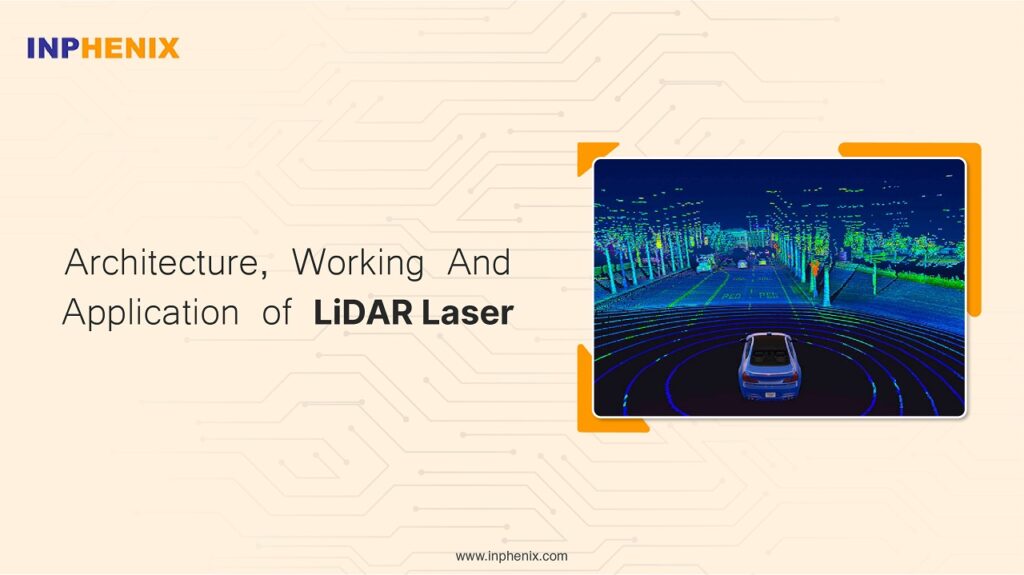
Assume you drove your car to a remote tourist destination last Christmas. Nonetheless, even though you were unfamiliar with the location or were visiting it for the first time, you made it safely. How did you do that? Well, the most probable answer could be that you used Google Maps along with the LiDAR laser technology installed in your car.
Everyone who owns a car is familiar with the 3-D color map of your immediate surroundings that the car display monitor shows while you travel. This generates a map of the area around you and displays it to the driver, helping them in safe driving. But what is the name of this technology? It’s known as a LiDAR laser, which stands for Light Detection and Ranging.
So, how does LiDAR system work and what components are used to build it? Let’s find out!

A typical lidar architecture has major four lidar system components: 1) transmitter (light source), 2) receiver (light detection), 3) signal detection system and 4) data acquisition and control system. Again, the LiDAR architecture can be built in two ways: biaxial or coaxial.
This configuration aids in avoiding near-field backscattered radiation, which could saturate the photodetector.
In contrast, the axis of the LiDAR Laser beam coincides with the axis of the receiver optics in a coaxial system. As a result, the receiver may see the laser beam in the zero-range bins.
Moreover, in a coaxial system, the near-field backscattering problem can be solved by either gating the photodetector or using a fast shutter or chopper to block the near-field scattering.
It should be noted that the majority of current LiDAR lasers are monostatic, with either a biaxial or a coaxial setup. The detection range usually dictates whether a biaxial or coaxial setup is used. A coaxial setup is desirable if the near field range is required since it allows for complete overlap of the receiver field-of-view with the laser beam.
If a near-field range is not required, a biaxial configuration may help prevent photodetector saturation due to significant near-field scattering. Scanning capabilities can also play a role in deciding whether to use biaxial or coaxial wires.
Now, let’s look at how the LiDAR laser works.
The functioning of a LiDAR laser is quite simple. The bottom line is to figure out how long it takes for a light beam to hit an object and rebound to the detector. Then compute the distance using the transit time, record the angle, and use this data to map out where the reflecting object is in the 3-D structure.
This method is more difficult to achieve high accuracy since it requires knowing where the plane is within a centimeter or so as it travels at 100 to 200 mph, bouncing up and down while monitoring hundreds of thousands of LiDAR laser pulses every sec.
LiDAR laser technologies, on the other hand, have advanced tremendously. The first commercial systems were bulky and complicated, with speeds of up to 10,000 points per second (10 kilohertz). The latest systems are compact, lighter, and have higher precision.
The lidar laser is used in many important scientific and commercial applications due to its accurate surface scanning ability. Some of them are as follows.
LiDAR lasers are effective at scanning surfaces, and having this capability is very beneficial when conducting search and rescue missions. When connected to a laser, this sensor can quickly identify people on any surface, helping search and rescue personnel locate a missing person. The rescuer can choose how to safely retrieve the victim after finding it. Rescue efforts can be easily conducted at night as the sensors don’t require light to collect data.
A lidar laser can be used to measure the location of mineral extraction in mining. This is calculated by matching the surface data with the previous scan. Because they are a faster and more cost-effective choice than surveying with aircraft, lasers are frequently employed to survey mines. Mines are also surveyed using mobile mappers with sensors and terrestrial laser scanners. Lidar laser integration into mining operations reduces risk exposure, cost and time.
LiDAR technology is the perfect solution for urban planners searching for a strong instrument to aid in the expansion of rail stations and mass transport networks. LiDAR-equipped UAVs can scan large regions and produce informative data that can be used to develop future transportation infrastructure plans.
Lidar Lasers may be used to scan the atmosphere over great distances in order to monitor exact changes in wind velocity. The lidar has revolutionized the field of meteorology science. With the help of lidar, changes in the atmosphere can be analyzed and chemical or physical particles in the cloud can also be studied. It also helps the meteorologist in weather forecasting.
Electricity has become as essential as water today. There are many ways to produce it but the world is moving towards green energy production. Among them, solar and wind energy generation are the best options. Lidar lasers are very useful in both of these.
With the help of lidar technology, you can know the wind direction and find the best position for the solar panel to generate maximum electricity.
Inphenix is a US-based company that produces high-quality LiDAR lasers and other light sources. Along with light sources, they deal with lasers, driver boards, superluminescent diodes, semiconductor optical amplifiers, and O-band optical amplifiers. Visit the website to learn more about our expertise, products, and services.
